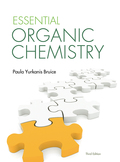
Concept explainers
(a)
Interpretation:
Mechanism of compound are synthesized by the use of only provided carbon-containing compounds has to be given.
Concept introduction:
Required compounds are synthesized by the use of only provided carbon-containing compounds through a series of steps.
In first case, given alcohol is oxidized to a
In second case, given alcohol is oxidized to a ketone. A strong base is added to the ketone. Aldol condensation reaction takes place. Hydrazine in alcoholic potassium hydroxide is added in the aldol condensation product to remove the carbonyl group. The intermediate
In third case, ethanol is oxidized to acetaldehyde. Acetaldehyde undergoes aldol addition reaction in presence of a strong base. Aldol addition product is reduced to form a
(b)
Interpretation:
Mechanism of compound are synthesized by the use of only provided carbon-containing compounds has to be given.
Concept introduction:
Required compounds are synthesized by the use of only provided carbon-containing compounds through a series of steps.
In first case, given alcohol is oxidized to a ketone. A strong base is added to the ketone. Aldol condensation reaction takes place. The aldol product is reduced and the final compound is obtained.
In second case, given alcohol is oxidized to a ketone. A strong base is added to the ketone
Aldol condensation reaction takes place. Hydrazine in alcoholic potassium hydroxide is added in the aldol condensation product to remove the carbonyl group. The intermediate alkene is reduced to give the final compound.
In third case, ethanol is oxidized to acetaldehyde. Acetaldehyde undergoes aldol addition reaction in presence of a strong base. Aldol addition product is reduced to form a diol compound 1. Other alcohol is oxidized to an acetone and converted to diol compound 2. Compound 1 and 2 combine to form the final product and two molecules of water are reduced.
Want to see the full answer?
Check out a sample textbook solution
Chapter 13 Solutions
EBK ESSENTIAL ORGANIC CHEMISTRY
- Can I get helpp drawing my arrowsarrow_forwardWhich of the m/z values corresponds to the base peak in the mass spectrum shown? 100 80 A. 45 B. 44 C. 29 D. 15 Intensity 20 0 10 20 30 40 B- m/z -8 50 E. 30 Which of the m/z values correspond to the molecular ion for the compound shown? A. 18 B. 82 OH C. 100 D. 102 E. 103arrow_forwardCan someone help me with drawing my arrows.arrow_forward

 Organic ChemistryChemistryISBN:9781305580350Author:William H. Brown, Brent L. Iverson, Eric Anslyn, Christopher S. FootePublisher:Cengage Learning
Organic ChemistryChemistryISBN:9781305580350Author:William H. Brown, Brent L. Iverson, Eric Anslyn, Christopher S. FootePublisher:Cengage Learning

